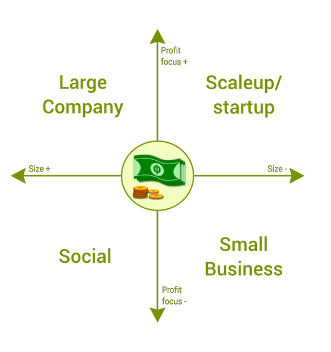CAT Exam > CAT Notes > CMAT Mock Test Series > Meaning of Entrepreneurship
Meaning of Entrepreneurship | CMAT Mock Test Series - CAT PDF Download
| Table of contents |

|
| Who is an Entrepreneur? |

|
| Characteristics of Entrepreneurship |

|
| Types of Entrepreneurship |

|
| Importance of Entrepreneurship |

|
| Barriers to Entrepreneurship |

|
Who is an Entrepreneur?
An entrepreneur is an individual capable of establishing, managing, and succeeding in a new business venture, even in the face of potential losses, with the aim of maximizing profits. They are recognized as innovators who introduce new ideas and products to enhance society's well-being.

Characteristics of Entrepreneurship
- Entrepreneurship aims at generating substantial profits and enhancing shareholder value.
- Successful entrepreneurs strategically hire skilled and professional human resources.
- Not all hired human assets lead to success in entrepreneurship.
Entrepreneurial Qualities
- Risk-taking Ability: Entrepreneurs must be willing to accept the potential for failure in new ventures. This requires courage and the capacity to assess and take risks effectively, which is a crucial trait for an entrepreneur. For instance, successful entrepreneurs like Elon Musk have demonstrated a high tolerance for risk in their pursuit of groundbreaking innovations.
- Innovativeness: Innovation is a key characteristic essential for successful entrepreneurship, enabling individuals to adapt to evolving business landscapes. Entrepreneurs need to constantly generate fresh and unique ideas, launch new products, and enhance efficiency. A prime example is how companies like Apple continuously innovate their products to meet consumer demands and stay ahead in the market.
- Vision and Leadership: Entrepreneurs should possess a clear vision for their startup and exhibit strong leadership skills to inspire and guide their team towards success. Visionary leaders like Jeff Bezos, the founder of Amazon, have been able to steer their companies to great heights through a combination of foresight and effective leadership.
- Open-mindedness: An entrepreneur's ability to view challenges as opportunities is crucial for business success. Being open-minded allows entrepreneurs to capitalize on changing circumstances for their company's benefit. For example, companies like Netflix embraced the shift to streaming services early on, transforming challenges into opportunities for growth and innovation.
- Flexibility: Flexibility is essential for entrepreneurs to adapt to dynamic business environments and changing consumer preferences. Entrepreneurs who can pivot quickly in response to market demands, such as Airbnb adjusting its business model during the pandemic, are better positioned for long-term success.
- Product Knowledge: Understanding the products and services offered by a company is fundamental for entrepreneurial success. Entrepreneurs must stay informed about market trends and consumer needs to ensure their offerings remain relevant and competitive. Companies like Tesla, led by Elon Musk, prioritize in-depth product knowledge to drive innovation and meet customer expectations.
Types of Entrepreneurship
 Types of Enterpreneurship
Types of Enterpreneurship
- Small Business Entrepreneurship: Small business entrepreneurship encompasses businesses that operate on a smaller scale, such as local grocery stores, carpenters, consultants, electricians, travel agents, plumbers, and hairdressers. These businesses are typically owned by individuals with support from family members or local employees. The profits generated are modest and primarily cater to sustaining the family rather than expanding into larger enterprises. Entrepreneurs in this category often rely on small loans from banks, friends, or family.

- Scalable Startup Entrepreneurship: Scalable startup entrepreneurship is centered around creating significant positive changes on a larger scale. These entrepreneurs seek funding from investors who are interested in supporting unique ideas and innovative plans. They emphasize scalable business models and experimentation, aiming to recruit the most qualified employees. This type of entrepreneurship requires substantial venture capital to fuel business operations.

- Large Company Entrepreneurship: Large company entrepreneurship involves businesses that operate on a significant scale with branches in multiple locations. These companies follow a defined life cycle and focus on growth and sustainability by introducing new and innovative products to their customer base. They constantly adapt to changes in technology, customer preferences, market trends, and competition. To stay competitive, these companies must innovate not only in product manufacturing but also in sales strategies to attract new customers and outperform rivals. They may choose to acquire innovative enterprises or develop new products internally to maintain their market position.

- Social Entrepreneurship: Social entrepreneurship is aimed at producing those products and services that help in solving the problems and issues of society and fulfilling social needs. These entrepreneurs are focused on serving society not on earning profits.

Importance of Entrepreneurship
- Creation of Jobs: Entrepreneurship plays a crucial role in creating employment opportunities, especially for individuals who are new to the workforce. It not only helps in enhancing their resumes but also provides them with valuable experience, training, and skills.
- Encouraging Innovation: Entrepreneurs contribute to fostering innovative ideas and plans. They introduce new products, technologies, services, and markets, leading to societal development and an improved standard of living. Innovation in entrepreneurship saves time, money, and resources.

- Positive Impact on Society: The diverse range of job opportunities generated by entrepreneurship contributes to the overall development of society. It enhances the quality of life by increasing investments in education, healthcare, sanitation, reducing poverty, and minimizing slums. In essence, entrepreneurship enhances community life significantly.
- Enhancing Standard of Living: Entrepreneurship boosts the standard of living by providing employment opportunities and increasing income levels. This results in higher consumption of goods and services, thereby enhancing the quality of life for individuals and households.
- Support for Research and Development: Before launching new products or services, entrepreneurs invest in thorough research and testing to mitigate market uncertainties. They allocate funds to research institutions and universities, fostering research, infrastructure development, and overall economic growth of a country.
Barriers to Entrepreneurship

(i) Environmental Barriers
- Environmental barriers refer to external factors that can hinder entrepreneurial activities.
- Examples include:
- Non-availability of raw materials: When necessary resources are not easily accessible, it can impede production processes.
- Shortage of skilled labor: Difficulty in finding qualified workers can limit business operations and growth.
- Change in technology: Rapid advancements may render current methods or products obsolete, requiring costly adaptations.
- Poor infrastructure: Inadequate facilities like transportation or communication networks can disrupt business functions.
- Natural calamity: Disasters such as earthquakes or floods can devastate businesses and their surroundings.
(ii) Financial Constraints
- Financial barriers pertain to challenges related to funding and monetary resources.
- Factors contributing to financial constraints include:
- Poor management: Inefficient handling of funds can lead to financial instability and business failure.
- Delay in decisions: Procrastination in making crucial financial choices can hinder growth opportunities.
- Ineffective & inefficient personnel: Incompetent staff can mismanage finances, affecting the company's financial health.
- Poor performance: Subpar business outcomes can deter potential investors and lenders.
(iii) Personal Barriers
- Personal barriers are internal obstacles that can impede entrepreneurial success.
- Examples of personal barriers include:
- Lack of confidence: Self-doubt can prevent individuals from taking risks or pursuing new ventures.
- Lack of motivation: A lack of drive and enthusiasm may result in procrastination and missed opportunities.
- Lack of patience: Impatience can lead to hasty decisions that are detrimental to business growth.
- Fear of failure: Fear can paralyze individuals, preventing them from venturing into unknown territories.
- Inability to dream: A lack of vision or creativity can limit innovative thinking and problem-solving abilities.
(iv) Society Barrier
- Societal barriers encompass external factors arising from the community or cultural norms.
- Barriers stemming from society include:
- Entrepreneurial behavior: Social expectations or norms may discourage entrepreneurial initiatives.
- Financial instability: Economic fluctuations can create uncertainty and hinder business growth.
- Socio-cultural norms: Cultural beliefs or practices may clash with entrepreneurial values or practices.
(v) Political Barrier
- Political barriers involve challenges related to government policies and regulations.
- Political barriers may include:
- Government's taxation policies: Tax laws can impact business profitability and financial planning.
- Government's interest in economic development: Political priorities may not align with fostering entrepreneurship.
- Government's incentives and concessions: Lack of support or favorable policies can hinder entrepreneurial growth.
The document Meaning of Entrepreneurship | CMAT Mock Test Series - CAT is a part of the CAT Course CMAT Mock Test Series.
All you need of CAT at this link: CAT
|
19 videos|59 docs|26 tests
|
FAQs on Meaning of Entrepreneurship - CMAT Mock Test Series - CAT
| 1. What are the key characteristics of entrepreneurship? |  |
Ans. Some key characteristics of entrepreneurship include innovation, risk-taking, creativity, passion, and determination. Entrepreneurs are often willing to take on challenges and think outside the box to create new opportunities.
| 2. What are the different types of entrepreneurship? |  |
Ans. There are various types of entrepreneurship, including small business entrepreneurship, scalable startup entrepreneurship, social entrepreneurship, and corporate entrepreneurship. Each type focuses on different goals and approaches to business.
| 3. Why is entrepreneurship important? |  |
Ans. Entrepreneurship is important for economic growth as it drives innovation, creates jobs, and fosters competition. It also leads to new products and services that can improve people's lives and contribute to overall societal development.
| 4. What are some common barriers to entrepreneurship? |  |
Ans. Some common barriers to entrepreneurship include lack of access to capital, regulatory hurdles, limited market knowledge, and fear of failure. Overcoming these barriers is crucial for aspiring entrepreneurs to succeed.
| 5. What are some key concepts in entrepreneurship and political barriers? |  |
Ans. Key concepts in entrepreneurship include opportunity recognition, business planning, marketing strategies, and financial management. Political barriers can include government regulations, taxation policies, and bureaucratic red tape that can hinder the growth of entrepreneurial ventures.
Related Searches
















